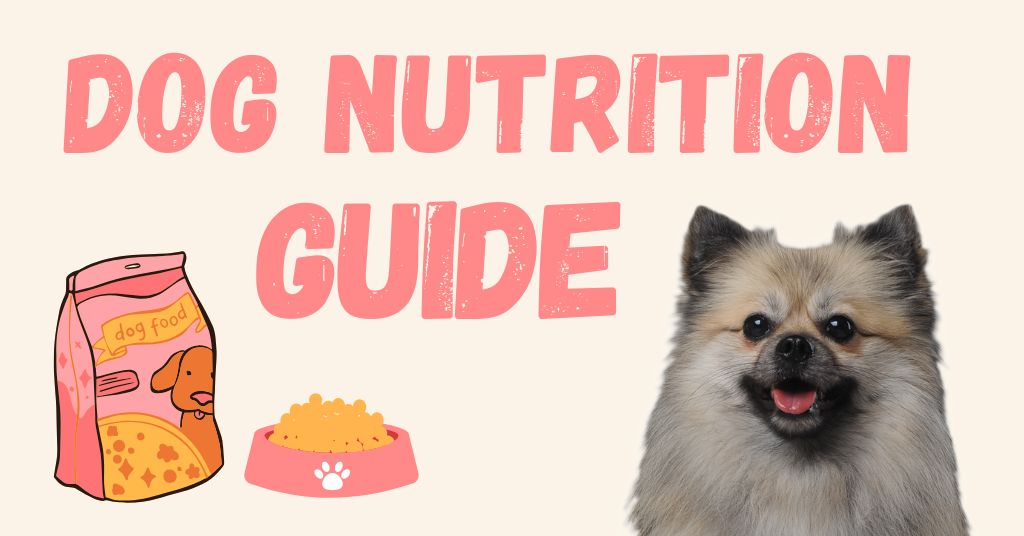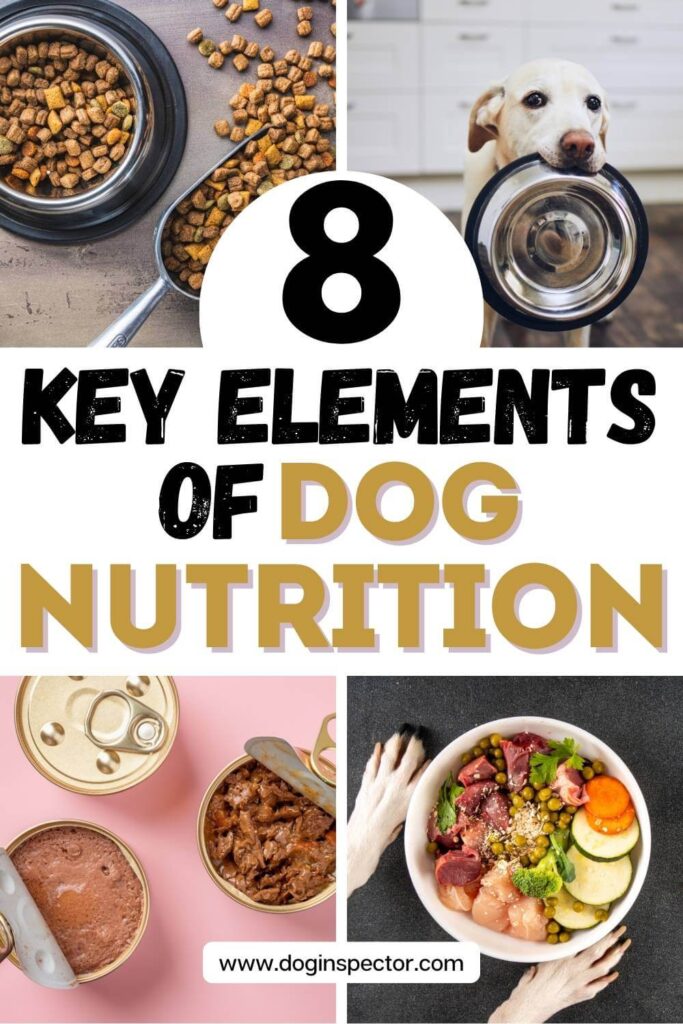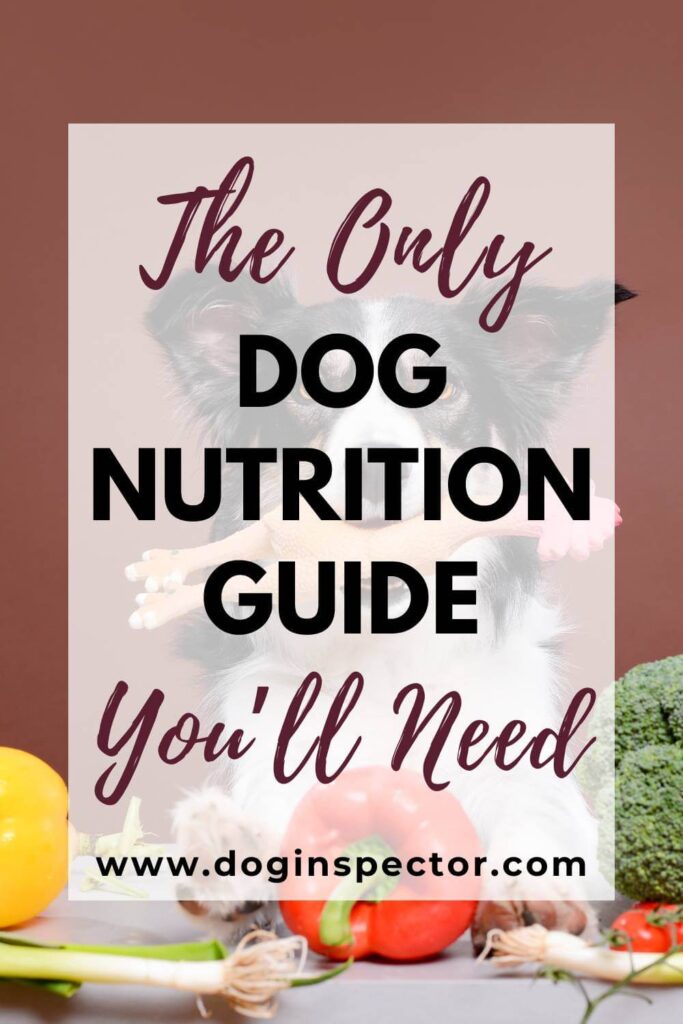Dog Nutrition Guide: 8 Key Elements to Know
This post shows you everything you need to know about dog food, and you can use it as the ultimate dog nutrition guide.
I started Dog Inspector because I was on a journey to learn more about dog nutrition, and I became a certified dog nutritionist. When I studied for the final exam, I read a lot about dog health and had to learn about the different nutritional needs dogs have. I was surprised to learn that dogs need fat in their diet almost equally as much as protein and that they definitely don’t need to be on grain-free diets by default!

- Dog Nutrition Guide – Part 1: Protein
- Dog Nutrition Guide – Part 2: Fats
- Dog Nutrition Guide – Part 3: Carbs
- Dog Nutrition Guide – Part 4: Fiber
- Dog Nutrition Guide – Part 5: Fat-soluble vitamins
- Dog Nutrition Guide – Part 6: Water-soluble vitamins
- Dog Nutrition Guide – Part 7: Minerals
- Dog Nutrition Guide – Part 8: Water
- Practical tips for feeding
In this post, I’ll explain everything about:
Let’s get started!

Dog Nutrition Guide – Part 1: Protein
Let me start by saying that to keep dogs healthy, you need to give them all the nutrients they need. Don’t exclude any food groups (unless told otherwise by your vet), as dogs need high-quality nutrients to thrive.
One of the really good manuals I like to read and use is the Merck Manual for Small Animals. Check it out!
Now, back to protein. Dogs need protein because it’s the foundation for their muscles, skin, and organs. Protein plays a key role in repairing tissue and supporting growth, so puppies especially need a protein-rich diet to grow up strong.
Protein is also an essential source of energy, so active dogs need more of it, just like we do. It helps keep their body and organs running properly. Without enough protein, dogs can struggle with weight loss and losing their coat and fur. Protein not only builds and repairs muscles but also helps dogs recover from injuries.
The best protein sources for dogs
The best protein sources for dogs are lean meats like chicken, turkey, and lean beef.
Then there’s fish like salmon.
Eggs are also a great source of protein and minerals, as well as plain yogurt, which your dog can enjoy if they can tolerate lactose (most dogs actually can).
Some plant-based proteins are okay, too, like lentils and chickpeas, but they often cause gas and bloating, so don’t overdo it. Also, they shouldn’t entirely replace animal-based proteins.
How much protein do dogs need?
It really depends on the size, age, and activity level of your dog.
How to tell if dog kibble has enough protein
Most of a dog’s protein intake should come from high-quality kibble that meets AAFCO standards. AAFCO stands for the Association of American Feed Control Officials. It is a non-governmental organization that sets guidelines for pet food labeling and nutritional standards. While AAFCO doesn’t regulate or test pet food, its guidelines ensure manufacturers produce foods that meet minimum nutritional requirements for pets at different life stages.
You can learn more about AAFCO here: https://www.aafco.org
When you read the ingredients on the kibble, protein should come first. Sometimes, it will say “chicken meal” or other sources of protein and then list all the protein sources.
Ingredients are listed by weight, so you’ll want to see high-quality proteins like chicken, turkey, beef, or fish listed first. Avoid foods where fillers like corn or wheat gluten dominate the list and are listed first.
Additionally, you need to buy food that’s appropriate for your dog’s age! There are different kibble formulas for puppies, senior dogs, small dogs, adult dogs, and more. Make sure the food matches your dog’s specific needs.
Dog Nutrition Guide – Part 2: Fats
Did you know that when kibble is made in factories under high temperatures, it’s also sprayed with animal fat to make it more appealing for dogs?
But this is actually good, as fats are essential for your dog. They are an important source of energy. In addition to providing energy, fat also helps absorb fat-soluble vitamins like D, E, and K.
The most important type of fat in a dog’s diet is the essential fatty acids that dogs can’t produce on their own.
Fat supports a dog’s brain function. There are also medium-chain triglycerides (MCTs) that help with memory and cognitive decline.
In addition, fats are important for energy, immune function, reproductive health, and maintaining healthy skin and a shiny coat.
The best fat sources for dogs
The best sources of fats for dogs include omega-3 and omega-6 fatty acids. The best sources of omega-3 and omega-6 are fish oil, flaxseed oil, and vegetable oils like corn and soy.
Next, animal fats from chicken, beef, and eggs are also excellent sources of fat for dogs!
I mentioned medium-chain triglycerides (MCTs) that help with memory. Well, coconut oil is a good source, too!
How much fat do dogs need?
Most of your dog’s fat intake should come from high-quality kibble. Good kibble will have animal fat (chicken, beef, or fish) and sometimes added plant-based oils like sunflower or flaxseed.
Salmon oil and coconut oil are also popular supplements for dogs, but you have to be careful not to overdo them.
Dog Nutrition Guide – Part 3: Carbs
You’ll never see carbs as an essential part of any dog nutrition guide, as dogs don’t need carbohydrates to survive. But carbs are still important for dogs. Here’s how.
We all know that carbs are a source of energy. They provide glucose to the brain, blood, and muscles. This is especially important when extra energy is needed. Think of growing children, pregnancy, nursing, high-intensity training, and other times of high energy demand.
Carbs help dogs by giving them energy so they can maintain their muscle mass and grow while allowing protein to be used for other important functions. If it weren’t for carbs, the body would have to rely on protein or fat to create this energy, which can interfere with other processes.
The best carb sources for dogs
The best carbohydrate sources for dogs are well-cooked grains like rice, oats, and barley. Next, there are nutritious vegetables like sweet potatoes.
In kibble, the most popular carbs are rice, followed by barley, oats, and peas. Peas are good for dogs (you can read more about it in my article about peas and dogs), but it’s not good when you always see them as the first ingredient in dog kibble!
The first ingredient listed on the label of high-quality dog kibble should be protein, followed by fat, and then healthy grains.
How many carbs do dogs need?
Dog Nutrition Guide – Part 4: Fiber
There’s no strict or universal rule when it comes to how much fiber dogs need, but it’s proven that eating fiber has significant health benefits.
Fiber is important for gut health, as it supports the growth of good bacteria. These bacteria then provide energy to the cells in the intestines, maintaining a healthy gut.
Another major benefit of fiber is that it helps with stool quality. It can also regulate blood sugar.
Of course, too much fiber is never a good idea, as it can cause digestion issues and slow down the absorption of other nutrients.
The best fiber sources for dogs
Some of the best sources of fiber are vegetables and low-sugar fruits. Certain grains, like rice bran, also have good fiber content. When you’re giving these extra fiber treats to dogs, make sure they don’t make up more than 10% of their daily diet.
In kibble, you’ll want to look for good fiber sources such as beet pulp, rice bran, and cellulose.
How much fiber do dogs need?
However, suppose you want to help your dog with constipation or tummy issues. In that case, you can choose nutritious fruits and veggies rich in fiber, like apples, berries, sweet potatoes, carrots, zucchini, or celery.
Dog Nutrition Guide – Part 5: Fat-soluble vitamins
Just like us, dogs need a variety of vitamins to support essential body functions. Among these, fat-soluble vitamins—A, D, E, and K—are especially important.
Fat-soluble vitamins are absorbed with fat in the diet and stored in the body. Water-soluble vitamins, on the other hand, are not stored in the body.
Your dog will get most of these from their dog food, but let’s dive in and analyze why these vitamins are important.
Vitamin A
Vitamin D
Vitamin E
Vitamin K
Dog Nutrition Guide – Part 6: Water-soluble vitamins
Water-soluble vitamins include the vitamin C and vitamin B complex. There are several vitamins in the B complex that are important for your dog’s health.
Vitamin B
Vitamin C
Dog Nutrition Guide – Part 7: Minerals
Minerals support everything from bone strength to immune health.
Trace minerals like zinc, copper, iodine, selenium, and iron are just as important:
The best sources of these minerals are high-quality kibble or wet food.
On top of that, natural sources like fish, meat, eggs, dairy, and some vegetables are also rich in these minerals!
Dog Nutrition Guide – Part 8: Water
You’ll see this in every dog nutrition guide, but water and proper hydration are the most important aspects of your dog’s nutrition!
In most cases dehydration will be only mild and temporary. But dehydration can be very dangerous as it can affect the entire body and the temperature regulation.
How much water do dogs need?
Dogs can also “eat” their water, so feel free to give them foods like:
Practical tips for feeding
I hope you liked this dog nutrition guide. Which part is your favorite? Is there anything that I may have missed? Let me know in the comments—I’d love to get some feedback.
And don’t forget to pin this post so you’ll always have this guide handy.
Love, life, and fur forever!

This post showed you Dog Nutrition Guide: 8 Key Elements to Know.
You may also like: